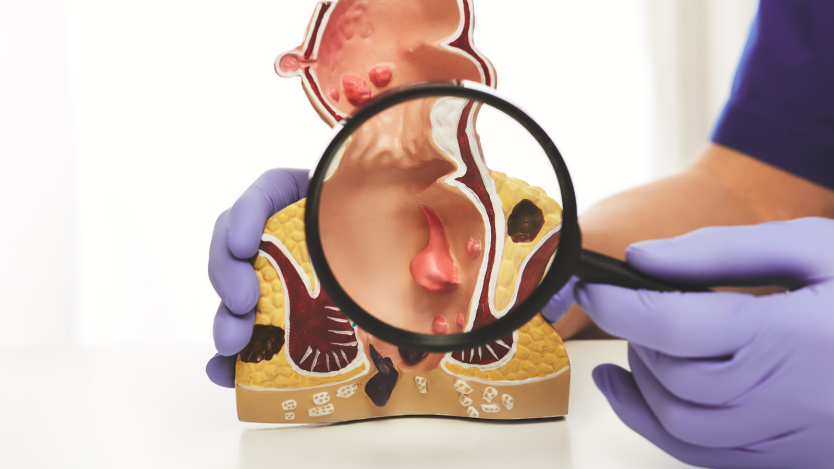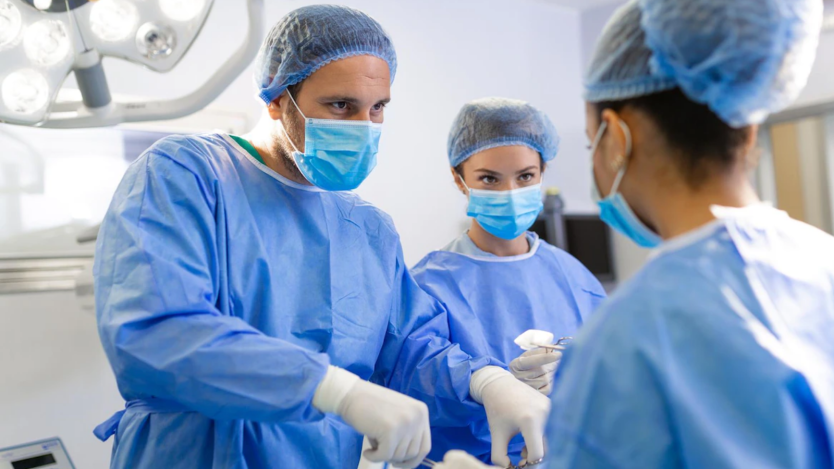What types of treatments are there for haemorrhoids?

- What are haemorrhoids?
- Treatment at home
- Non surgical procedures
- Haemorrhoid removal surgery
- Bibliography
- Source information
- Frequent Questions
What are haemorrhoids?
Haemorrhoids are a collection of tissues and veins whose function is to cushion the anal canal and help maintain continence.
When haemorrhoidal disease occurs, these structures, known as piles, become congested, inflamed and prolapse outwards from the anal canal. This is usually caused by excessive pressure on the collapsed area from pregnancy, overweight, constipation or other conditions such as anal fissure or anal fistula.

Do you need haemorrhoids surgery?
Request a free and immediate appointment with our specialists in General surgery
It is a very common problem, as data show that 50% of the population will suffer some symptoms during their lifetime. However, it is not generally a serious problem, although depending on the degree and size of the haemorrhoid, it will cause discomfort such as itching, burning or pain.
The development of haemorrhoids tends to be more common in adults around 45-65 years of age.
Treatment at home
Home treatments can relieve the mild pain and inflammation of grade I and II haemorrhoids, i.e. small and uncomplicated haemorrhoids. Here are the most common indications, which are often successful in minimising symptoms.
Indications for mild symptoms
Some of the guidelines for treating piles with hygienic-dietary measures are:
- Drink plenty of fluids.
- Eat a diet rich in fibre, fruit and vegetables.
- Eliminate alcoholic beverages and spicy or very spicy foods.
- Reduce caffeine intake (coffee, tea, cola, etc.).
- Avoid abuse of medication: non-steroidal anti-inflammatory drugs (ibuprofen or naproxen), anxiolytics and antidepressants.
- Avoid long periods of sitting on the toilet.
- Cleanse the area with aloe-vera or medicated anal wipes.

Care for moderate symptoms
In addition to the above measures, the following indications can be added in case of moderate symptoms:
- Use of laxatives: Taking these drugs will help to achieve a formed stool, thus avoiding straining to defecate.
- Suppositories and ointments: these can be useful in acute, uncomplicated cases to lubricate, reduce pain, relieve itching, reduce inflammation, protect the mucosa and promote healing. Always bearing in mind that some may contain corticosteroids and cause side effects, so they should not be used for more than 5-7 days.
- Sitz baths with warm water: recommended in cases of haemorrhoidal crises.
- Venotonic medication: reduce oedema by reducing bleeding through the anus (rectorrhagia) in the initial stages.
Non surgical procedures
These treatments cure most small and some large internal haemorrhoids. They are not used for external haemorrhoids. They work by interrupting the blood supply to the haemorrhoid, which causes the haemorrhoid to shrink or disappear.

Do you need haemorrhoids surgery?
Request a free and immediate appointment with our specialists in General surgery
Non-surgical procedures are less risky and less painful than surgery. They require less time away from work and other activities.
- Banding treatment: The doctor places an elastic band around the base of the haemorrhoid, which cuts off the blood supply. After a few days, the haemorrhoid disappears. It is effective for treating haemorrhoids that are not in stage IV.
- Sclerotherapy: A medicine is injected to shrink the haemorrhoid, which will eventually shrink over time. This treatment is usually effective in cases of grade II and III haemorrhoids. It is an alternative to elastic bands.
- Infrared coagulation: Also called infrared light coagulation, this is a treatment in which a device is used to burn the haemorrhoidal tissue. This technique is used for mild, grade I and II haemorrhoids.
Haemorrhoid removal surgery
Haemorrhoidectomy
This is the surgical removal of the excess tissue causing the bleeding. It can be performed in various ways and may involve a combination of an anaesthetic and local, spinal or general sedation.
During the procedure, incisions are made in the tissue surrounding the haemorrhoid. The swollen vein inside the haemorrhoid is tied off to prevent bleeding, and the haemorrhoid is removed. The surgical site may be stitched closed or left open. Finally, the wound is covered with gauze to protect the area and aid healing.
This surgery can be performed using a scalpel, a conventional procedure, or using a tool that uses electricity (electric scalpel) as well as a laser technique.
This type of surgery is the most effective in removing haemorrhoids completely, but there is a risk of complications, including defecation difficulties and urinary tract infections.

Haemorrhoid stapling
This type of intervention aims to block the blood flow in the haemorrhoidal tissue.
Stapled haemorrhoidopexy involves fixing and tightening the skin around your rectum or anal canal, stapling the haemorrhoid to the rectal wall at the base of the haemorrhoid. This procedure stops the blood flow to the haemorrhoid, which helps to reduce the swelling. The extra tissue will also be removed. Finally, a small sponge may be placed inside the anal canal to help stop the bleeding.
This procedure is usually less painful than haemorrhoidectomy. However, it can lead to an increased risk of recurrent haemorrhoids and rectal prolapse, where part of the rectum protrudes from the anus.
Don't at-home treatments improve the discomfort of haemorrhoids? If you are looking for the definitive solution, you can click on the image below and request a free surgical assessment consultation with our specialists:

Do you need haemorrhoids surgery?
Request a free and immediate appointment with our specialists in General surgery
Bibliography
- Tratamiento de las hemorroides. Usando métodos no quirúrgicos. (2020). Karames. Patient Education, 2-13. https://www.veteranshealthlibrary.va.gov/2211467_VA.pdf
- Moreira, V. F., & López San Román, A. (2006). Hemorroides. Revista Española de Enfermedades Digestivas, 98(3), 1. http://scielo.isciii.es/scielo.php?script=sci_arttext&pid=S1130-01082006000300009
- Geçim, E., Fazal Ali Khan, A., Arshad Cheema, M., Hayat Khan, W., & Farag, A. (2017, 24 abril). Manejo de la enfermedad hemorroidal. www.emjreviews.com/. https://emj.emg-health.com/wp-content/uploads/sites/2/2018/02/Manejo-de-la-Enfermedad-Hemorroidal.pdf
Dr. Antonio Rebollo Marina
Médico Asistencial en Centro Médico Caser
Nº colegiado: 282834715

Medical disclaimer: All the published content in Operarme is intended to disseminate reliable medical information to the general public, and is reviewed by healthcare professionals. In any case should this information be used to perform a diagnosis, indicate a treatment, or replace the medical assessment of a professional in a face to face consultation. Find more information in the links below:
Frequent Questions
-
What is good for reducing inflammation of haemorrhoids?
You can apply ice packs or cold compresses to the area for 15 minutes to relieve inflammation. This is usually a very effective treatment for large, painful haemorrhoids. Read more
-
How long do haemorrhoids last?
Generally, external haemorrhoids disappear after a few days, as long as you follow the hygienic-dietary indications: take sitz baths, increase the consumption of foods rich in fibre, drink plenty of water, ... Read more
-
How do you know if you have haemorrhoids?
- Swelling in the area.
- Burning or irritation of the skin.
- Pain and discomfort when sitting or having a bowel movement.
- Occasional bleeding, with or without pain.
